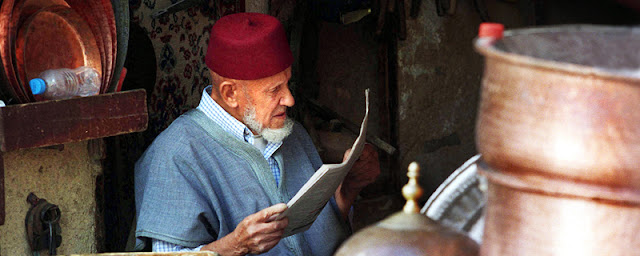Morocco's ambassador to the United Kingdom, HRH Princess Lalla Joumala Alaoui, was guest of honour at a Study Day given by the Temenos Academy in London on Saturday 27 November. Faouzi Skali, the recently re-appointed Director General of the Fes Festival of World Sacred Music, was one of three eminent Islamic scholars who spoke on the topic of Ethics, Virtue and Spiritual Chivalry in the Sufi Tradition. Our northern correspondent Aurora Borealis reports.

Faouzi Skali and Princess Lalla Joumala Alaoui in London
About 100 people gathered at The Window in Islington, London, to take part in the study day. The Window is a centre dedicated to inter-faith and spiritual activities. It provides excellent facilities and employs chefs who lay on a delicious lunch.
The day was organised by Sir Nicholas Pearson, Chairman of the Temenos Academy (www.temenosacademy.org) and a long-standing supporter of the Fes Sacred Music Festival. Princess Lalla Joumala has been a member of Temenos for five years and is well known for her interest in Sufism.
The first speaker was Dr Leonard Lewisohn who is a Sufi practitioner and Senior Lecturer in Classical Persian and Sufi Literature at the Institute of Arab and Islamic Studies at the University of Exeter, UK. Dr Lewisohn is the author of numerous works on Sufism and co-translator with Robert Bly of The Angels Knocking on the Tavern Door: Thirty Poems of Hafiz (HarperCollins 2008). Dr Lewisohn gave a fascinating account of the development of chivalry in medieval Persia. He spoke about how the groups that espoused it have long since died out, but that the principles are embedded in modern Iranian society – for example hospitality, generosity, compassion and modesty. He highlighted these virtues as both the groundwork for spiritual growth and the characteristics that manifest as a result of contemplative endeavour.
Princess Lalla Joumala arrived for Faouzi Skali's speech, following a very tasty vegetarian lunch. Dr Skali spoke eloquently in English about how the principles of chivalry laid the foundations for modern civilisation – and that the Sufi way is relevant both at an esoteric level and socially. It provides inspiration, he said, so that practitioners can develop personal transformation which extends into their daily lives. Sufism, he said, has its roots in both contemplation and social action. He did, however, acknowledge that the modern world seems to be engaged in a conspiracy against spiritual life – ego, he said, is the veil that conceals the truth.
The final talk came from Dr Lloyd Ridgeon, Reader in Islamic Studies at Glasgow University, Scotland. He is the author of Morals and Mysticism in Persian Sufism:A History of Sufi-futwwat in Iran (Routledge 2010). Dr Ridgeon's contribution included a Powerpoint presentation illustrating the contemporary Zurkhaneh movement in Iran which has its origins in chivalry, but which today gives young men opportunities to practise a variety of physical exercises and skills together – under the leadership of a master. The disciplines they practise include stick fighting, wrestling, spinning (like dervishes), weight-lifting and postures that resemble yoga. This was fascinating insight into an ancient tradition transposed into a contemporary context. It echoes with the Falun Gong movement in China.
There were question and answer sessions. During one of them, Faouzi Skali was asked to recommend a daily meditation. His response was la illah ha illah la.












